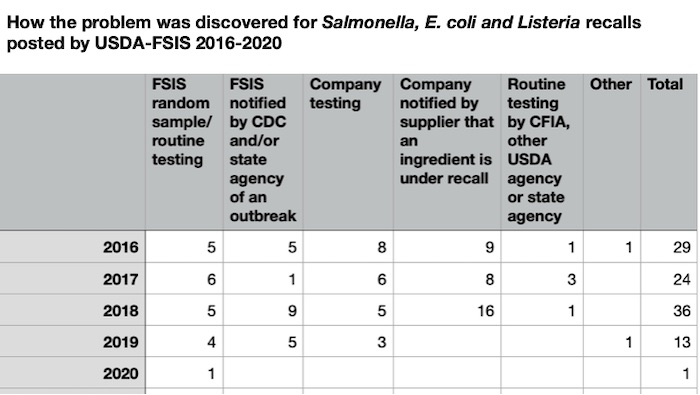When Food Poisoning Bulletin began a review of food recalls in 2020, it discovered there had been a dramatic decline in the number of recalls for meat and poultry but not for other food products. In order to look for an underlying cause, the food safety information site published analyzed five years of recall data published by the U.S. Department of Agriculture’s Food Safety and Inspection Service (USDA FSIS), the federal agency that regulates meat, poultry, and eggs.
That research showed that meat and poultry recalls plummeted to an all-time low this year. Just 29 recalls were issued for meat and poultry in 2020 (through December 10) and only one of them was for bacterial contamination. Those numbers are a fraction of the annual averages since 2016 – 128 recalls with 26 for bacterial contamination.
What is the reason for this decline, fewer inspections, less testing? If so, is the coronavirus pandemic to blame? And, if our food safety guardrails were disrupted in 2020, who was minding the safety of our nation’s meat and poultry supply?
When contacted for comment about the reason for the decline, a USDA FSIS spokesperson told Food Poisoning Bulletin that the agency has met all of its inspection obligations and regulatory functions throughout the pandemic and one reason that recalls may have fallen off is that the Centers for Disease Control and Prevention (CDC) reported fewer outbreaks this year than the previous two years.
The CDC has reported fewer outbreaks this year (10) than it did in 2019 (17) and 2018 (24). The 2020 total is closer to the number of outbreaks reported in 2017 (8) and 2016 (14) and a closer look at those outbreaks reveals the USDA-FSIS explanation doesn’t hold up.
For example, in 2016 one of the 14 outbreaks the CDC reported was for a food product regulated by USDA FSIS. That year, the agency posted a total of 134 recalls, 29 for bacterial contamination. In 2017, the CDC announced eight multistate outbreaks. None of them was linked to a USDA-regulated product, yet the agency posted a total of 135 recalls, 24 of them for contamination with one of the three major pathogens E. coli, Listeria and Salmonella.
The only recall for potential bacterial contamination this year was discovered through routine testing by USDA FSIS. Normally, USDA FSIS product testing triggers about five recalls a year and another six discovered by company testing. In 2020, not a single recall for bacterial contamination was discovered through routine tests performed by companies.
Romaine lettuce is the suspected source of three of the remaining nine remaining outbreaks announced by the CDC this year. Romaine is sometimes an ingredient in USDA-regulated salads, but because those outbreaks haven’t been solved yet no recalls have been issued. Also unsolved is the only 2020 outbreak linked to a product regulated by USDA FSIS, a Listeria outbreak linked to Italian-style deli meat that includes 11 illnesses and one fatality.
All of the people sickened told outbreak investigators that they had eaten Italian-style deli meats, such as salami, mortadella, and prosciutto in the weeks before they became ill. They remembered buying these meats prepackaged and freshly sliced at deli counters at multiple store locations.
Most of the illnesses occurred In Massachusetts, where six of the seven people sickened said they purchased the deli meat from a grocery store chain. In October, USDA FSIS reported that it was using shopper card information to conduct a traceback investigation for the source outbreak but no further progress on that has been reported. There’s a zero-tolerance policy for Listeria in ready-to-eat foods, but neither the brand(s) of the product(s) nor the grocery store(s) selling it have been named and there’s been no recall.
The Role of COVID-19
In early April, when the first quarter of recall information became available, there was already a noticeable decline. News reports quoted experts saying there was nothing to worry about, that things would likely even out in the coming months. But that didn’t happen.
Before the end of April, we’d learn that COVID-19 was ravaging meat and poultry processing plants. Thousands of illnesses were reported in association with work inside these facilities, some of those sickened were USDA inspectors. By early May, more than 300 USDA inspectors were sick with COVID or in quarantine due to exposure. Three of them had died.
Temporary plant closures due to rolling COVID-19 outbreaks came to an end in June following an Executive Order from President Trump. “As of this morning, across the cattle, swine, and broiler sectors, processing facilities are operating more than 95% of their average capacity compared to this time last year,” U.S. Secretary of Agriculture Sonny Perdue announced on June 9, 2020. “In fact, beef facilities are operating at 98%, pork facilities are operating at 95%, and poultry facilities are operating at 98% of their capacity compared to the same time last year.”
What this means is that meat and poultry industries have been functioning at near-capacity levels since June, producing as much beef, pork, and chicken as ever, during a pandemic that has sickened thousands of workers and inspectors and creating a workforce shortage, yet there has only been one instance of bacterial contamination…a 97 percent reduction over previous years.
According to Food Poisoning Bulletin’s publisher, Food Safety Attorney Fred Pritzker, something seems off here. “Either the meat and poultry industries have had the most statistically unbelievable luck in 2020 or we just don’t know yet all that has been missed,” Pritzker said. “In the months to come, we will likely get a clearer picture of how COVID-19 affected food safety during 2020. And that picture probably won’t be a pretty one.”

